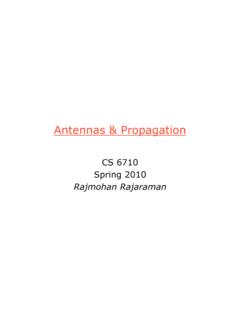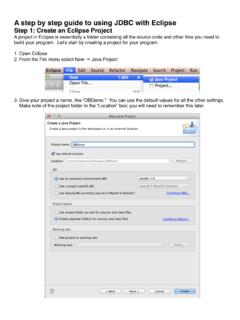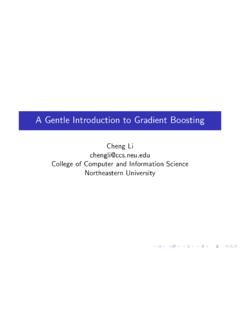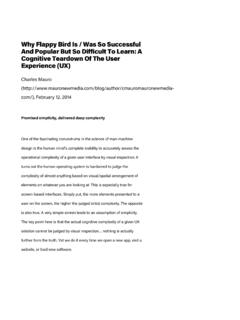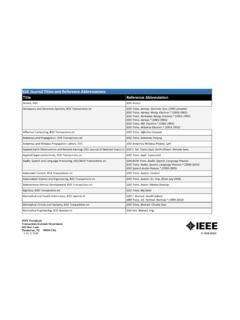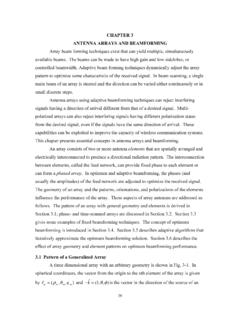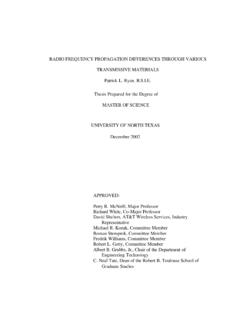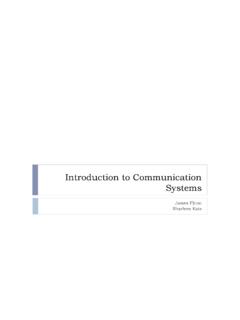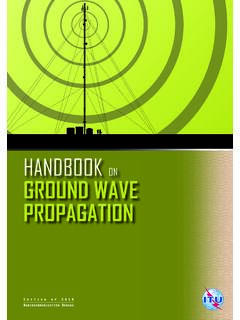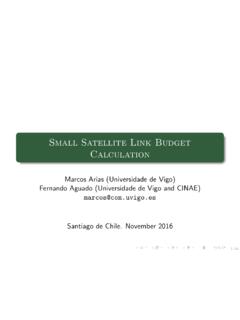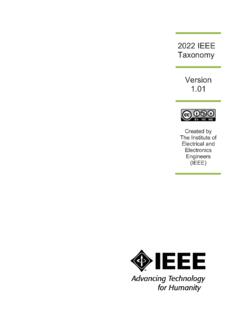Transcription of Antennas & Propagation - Khoury College of Computer …
1 Antennas & PropagationCS 6710 Spring 2010 Rajmohan RajaramanIntroduction An antenna is an electrical conductor orsystem of conductorsoTransmission - radiates electromagnetic energyinto spaceoReception - collects electromagnetic energyfrom space In two-way communication, the sameantenna can be used for transmission andreceptionRadiation Patterns Radiation patternoGraphical representation of radiation properties of anantennaoDepicted as two-dimensional cross section Beam width (or half-power beam width)oMeasure of directivity of antennaoAngle within which power radiated is at least half of thatin most preferred direction Reception patternoReceiving antenna s equivalent to radiation pattern Omnidirectional vs. directional antennaTypes of Antennas Isotropic antenna (idealized)oRadiates power equally in all directions Dipole antennasoHalf-wave dipole antenna (or Hertz antenna )oQuarter-wave vertical antenna (or Marconi antenna ) Parabolic Reflective AntennaoUsed for terrestrial microwave and satellite applicationsoLarger the diameter, the more tightly directional is thebeamAntenna Gain antenna gainoPower output, in a particular direction,compared to that produced in any direction bya perfect omnidirectional antenna (isotropicantenna) Expressed in terms of effective areaoRelated to physical size and shape of antennaAntenna Gain Relationship between antenna gain and effectivearea G = antenna gain Ae = effective area f = carrier frequency c = speed of light ( 3 x 108 m/s) = carrier wavelength22244cAfAGee!
2 "!== Propagation Modes Ground-wave Propagation Sky-wave Propagation Line-of-sight propagationGround Wave PropagationGround Wave Propagation Follows contour of the earth Can Propagate considerable distances Frequencies up to 2 MHz ExampleoAM radioSky Wave PropagationSky Wave Propagation Signal reflected from ionized layer of atmosphereback down to earth Signal can travel a number of hops, back andforth between ionosphere and earth s surface Reflection effect caused by refraction ExamplesoAmateur radiooCB radiooInternational broadcastsLine-of-Sight PropagationLine-of-Sight Propagation Above 30 MHz neither ground nor sky wavepropagation operates Transmitting and receiving Antennas must bewithin line of sightoSatellite communication signal above 30 MHz notreflected by ionosphereoGround communication Antennas within effective lineof site due to refraction Refraction bending of microwaves by theatmosphereoVelocity of electromagnetic wave is a function of thedensity of the mediumoWhen wave changes medium, speed changesoWave bends at the boundary between mediumsLine-of-Sight Equations Optical line of sight Effective, or radio, line of sight d = distance between antenna and horizon(km) h = antenna height (m) K = adjustment factor to account forrefraction, rule of thumb K = 4 !
3 = Equations Maximum distance between two antennasfor LOS Propagation : h1 = height of antenna one h2 = height of antenna two() !+!LOS Wireless TransmissionImpairments AttenuationoFree space loss Distortion Dispersion Noise Other effects:oAtmospheric absorptionoMultipathoRefractionAttenuati on Strength of signal falls off with distance overtransmission medium Attenuation factors for unguided media:oReceived signal must have sufficient strength so thatcircuitry in the receiver can interpret the signaloSignal must maintain a level sufficiently higher thannoise to be received without erroroAttenuation is greater at higher frequencies, causingdistortionFree Space Loss Free space loss, ideal isotropic antenna Pt = signal power at transmitting antenna Pr = signal power at receiving antenna = carrier wavelength d = Propagation distance between Antennas c = speed of light ( 3 x 108 m/s)where d and are in the same units ( , meters)()()222244cfddPPrt!
4 "!==Free Space Loss Free space loss equation can be recast:!"#$%&=='(dPPLrtdB4log20log10()() dB ++!=d"()()dB !+="#$%&'=dfcfd(Free Space Loss Free space loss accounting for gain of Antennas Gt = gain of transmitting antenna Gr = gain of receiving antenna At = effective area of transmitting antenna Ar = effective area of receiving antennaoIn the above formula, the powers correspond to that ofthe input signal at the transmitter and output at thereceiver, respectively()()()()trtrtrrtAAfcdAAdGGdP P2222224===!!"Free Space Loss Free space loss accounting for gain ofother Antennas can be recast as()()()rtdBAAdLlog10log20log20!+="()()( ) +!+!=rtAAdfPath Loss Exponents The free space path loss model is idealized Here the exponent depends on the transmissionenvironmentoUrban vs suburban, medium-city vs large-city,obstructed vs unobstructed, indoors vs outdoorsoGenerally between 2 and 4oObtained empirically Two-ray, ten-ray, and general statistical models!))
5 PtPr=Ad"Distortion Signals at higher frequencies attenuatemore than that at lower frequencies Shape of a signal comprising ofcomponents in a frequency band isdistorted To recover the original signal shape,attenuation is equalized by amplifyinghigher frequencies more than lower onesDispersion Electromagnetic energy spreads in spaceas it propagates Consequently, bursts sent in rapidsuccession tend to merge as theypropagate For guided media such as optical fiber,fundamentally limits the product RxL,where R is the rate and L is the usablelength of the fiber Term generally refers to how a signalspreads over space and timeCategories of Noise Thermal Noise Intermodulation noise Crosstalk Impulse NoiseThermal Noise Thermal noise due to agitation of electrons Present in all electronic devices andtransmission media Cannot be eliminated Function of temperature Particularly significant for satellitecommunicationThermal Noise Amount of thermal noise to be found in abandwidth of 1Hz in any device orconductor is: N0 = noise power density in watts per 1 Hz ofbandwidth k = Boltzmann's constant = x 10-23 J/K T = temperature, in kelvins (absolute temperature)()W/Hz k0TN=Thermal Noise Noise is assumed to be independent of frequency Thermal noise present in a bandwidth of B Hertz(in watts):or, in decibel-wattsTBNk=BTNlog10 log 10k log10++=BTlog10 log 10dBW ++!
6 =Other Kinds of Noise Intermodulation noise occurs if signals withdifferent frequencies share the same mediumoInterference caused by a signal produced at afrequency that is the sum or difference of originalfrequencies Crosstalk unwanted coupling between signalpaths Impulse noise irregular pulses or noisespikesoShort duration and of relatively high amplitudeoCaused by external electromagnetic disturbances, orfaults and flaws in the communications systemoPrimary source of error for digital data transmissionExpression Eb/N0 Ratio of signal energy per bit to noise powerdensity per Hertz The bit error rate for digital data is a function ofEb/N0oGiven a value for Eb/N0 to achieve a desired error rate,parameters of this formula can be selectedoAs bit rate R increases, transmitted signal power mustincrease to maintain required Eb/N0 TRSNRSNEbk/00==Other Impairments Atmospheric absorption water vapor andoxygen contribute to attenuation Multipath obstacles reflect signals so thatmultiple copies with varying delays arereceived Refraction bending of radio waves asthey propagate through the atmosphereFading Variation over time or distance of receivedsignal power caused by changes in thetransmission medium or path(s) In a fixed environment:oChanges in atmospheric conditions In a mobile environment.
7 OMultipath propagationMultipath Propagation Reflection - occurs when signal encounters asurface that is large relative to the wavelength ofthe signal Diffraction - occurs at the edge of animpenetrable body that is large compared towavelength of radio wave Scattering occurs when incoming signal hits anobject whose size is in the order of thewavelength of the signal or lessEffects of Multipath Propagation Multiple copies of a signal may arrive atdifferent phasesoIf phases add destructively, the signal levelrelative to noise declines, making detectionmore difficult Intersymbol interference (ISI)oOne or more delayed copies of a pulse mayarrive at the same time as the primary pulsefor a subsequent bitTypes of Fading Fast fadingoChanges in signal strength in a short time period Slow fadingoChanges in signal strength in a short time period Flat fadingoFluctuations proportionally equal over all frequencycomponents Selective fadingoDifferent fluctuations for different frequencies Rayleigh fadingoMultiple indirect paths, but no dominant path such as LOS pathoWorst-case scenario Rician fadingoMultiple paths, but LOS path dominantoParametrized by K, ratio of power on dominant path to that onother pathsError Compensation Mechanisms Forward error correction Adaptive equalization Diversity techniquesForward Error Correction Transmitter adds error-correcting code to datablockoCode is a function of the data bits Receiver calculates error-correcting code fromincoming data bitsoIf calculated code matches incoming code.
8 No erroroccurredoIf error-correcting codes don t match, receiver attemptsto determine bits in error and correctAdaptive Equalization Can be applied to transmissions that carry analogor digital informationoAnalog voice or videooDigital data, digitized voice or video Used to combat intersymbol interference Involves gathering dispersed symbol energy backinto its original time interval TechniquesoLumped analog circuitsoSophisticated digital signal processing algorithmsDiversity Techniques Space diversity:oUse multiple nearby Antennas and combine receivedsignals to obtain the desired signaloUse collocated multiple directional Antennas Frequency diversity:oSpreading out signal over a larger frequency bandwidthoSpread spectrum Time diversity:oNoise often occurs in burstsoSpreading the data out over time spreads the errors andhence allows FEC techniques to work welloTDMoInterleaving
